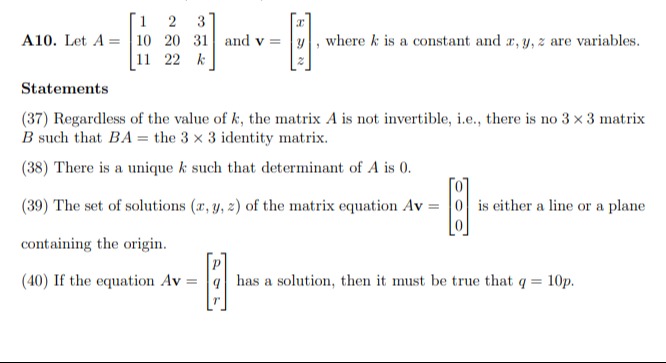Question
Question: Let $A = \begin{bmatrix} 1 & 2 & 3 \\ 10 & 20 & 31 \\ 11 & 22 & k \end{bmatrix}$ and $\mathbf{v} = ...
Let
A=1101122022331k and v=xyz, where k is a constant and x,y,z are variables.
Statements
(37) Regardless of the value of k, the matrix A is not invertible, i.e., there is no 3 x 3 matrix B such that BA = the 3 x 3 identity matrix.
(38) There is a unique k such that determinant of A is 0.
(39) The set of solutions (x,y,z) of the matrix equation Av=000 is either a line or a plane containing the origin.
(40) If the equation Av=pqr has a solution, then it must be true that q=10p.

(37), (39)
Solution
Let's analyze each statement.
Statement (37): Regardless of the value of k, the matrix A is not invertible, i.e., there is no 3 x 3 matrix B such that BA = the 3 x 3 identity matrix. A square matrix is invertible if and only if its determinant is non-zero. Let's calculate the determinant of A:
A=1101122022331k
det(A)=1⋅(20k−31⋅22)−2⋅(10k−31⋅11)+3⋅(10⋅22−20⋅11)
det(A)=(20k−682)−2⋅(10k−341)+3⋅(220−220)
det(A)=20k−682−20k+682+3⋅0
det(A)=0.
The determinant of A is 0 for all values of k. Since det(A)=0, the matrix A is singular and thus not invertible, regardless of the value of k. Statement (37) is true.
Alternatively, observe that the second column C2=22022 is twice the first column C1=11011, i.e., C2=2C1. Since the columns are linearly dependent (C2−2C1=0), the determinant of A is 0.
Statement (38): There is a unique k such that determinant of A is 0. We found that det(A)=0 for all values of k. This means there are infinitely many values of k for which the determinant is 0, not a unique value. Statement (38) is false.
Statement (39): The set of solutions (x,y,z) of the matrix equation Av=000 is either a line or a plane containing the origin. The equation Av=0 is a homogeneous system of linear equations. The set of solutions is the null space of A, which is a vector subspace of R3. A subspace always contains the origin 0. The dimension of the null space (nullity) is given by nullity(A)=number of columns−rank(A). Here, the number of columns is 3. Since det(A)=0, the matrix A is singular, so its rank is less than 3. rank(A)<3. The first two rows R1=[1 2 3] and R2=[10 20 31] are linearly independent because R2 is not a scalar multiple of R1 (10/1=10, 20/2=10, but 31/3=10). Since there are at least two linearly independent rows, the rank of A is at least 2. Since the rank is less than 3 and at least 2, the rank must be exactly 2. rank(A)=2. Now, calculate the nullity: nullity(A)=3−rank(A)=3−2=1. The dimension of the solution space is 1. A 1-dimensional subspace of R3 is a line passing through the origin. Therefore, the set of solutions is a line containing the origin. A line is one of the possibilities mentioned in the statement ("either a line or a plane"). Statement (39) is true.
Statement (40): If the equation Av=pqr has a solution, then it must be true that q=10p. The equation Av=b has a solution if and only if the vector b=pqr is in the column space of A. The column space of A is the span of its columns C1,C2,C3. C1=11011, C2=22022, C3=331k. We observed that C2=2C1. So, the column space is spanned by C1 and C3. The column space is the set of all linear combinations c1C1+c3C3.
pqr=c111011+c3331k=c1+3c310c1+31c311c1+kc3.
So, if a solution exists, we must have:
p=c1+3c3
q=10c1+31c3
r=11c1+kc3
Let's check if q=10p is necessarily true. From the first equation, c1=p−3c3. Substitute this into the second equation:
q=10(p−3c3)+31c3
q=10p−30c3+31c3
q=10p+c3.
This shows that if a solution exists, q is related to p and c3 (where c3 is determined by the specific linear combination of columns that forms b). The condition q=10p requires c3 to be 0. However, the vector b can be any vector in the column space. For example, if we choose b=C3=331k (by taking c1=0,c3=1), then p=3 and q=31. In this case, q=31 and 10p=10(3)=30. Since 31=30, the condition q=10p is not satisfied. Therefore, if the equation has a solution, it is not necessarily true that q=10p. Statement (40) is false.
Let's summarize the truth values of the statements:
(37) True
(38) False
(39) True
(40) False
The question asks which of the statements are correct. Statements (37) and (39) are correct. The options are not provided in the question, so we list the correct statements.
